Pros
Cons
Tour & Design
Sennheiser's MX W1s are a set of in-ear headphones that resemble the average Bluetooth headset.
[
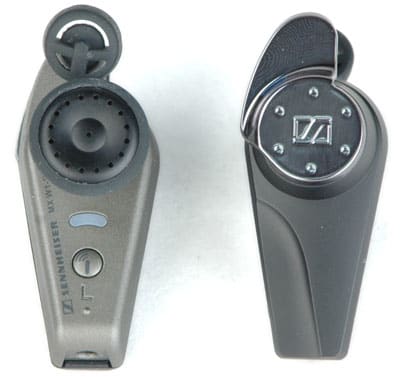
](../../images/upload/Image/Reviews/Sennheiser/MX_W1/front-back-800.jpg)
***The image on the left is the side that's getting pressed into your ear; the
image on the right is what the world will see pressed into your ear.***
Below is the side view of the MX W1s. The big ear piece is the ear bud and the small rubber bit above it helps stabilize the headphones in your ear.
[
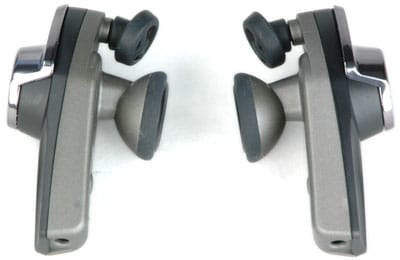
](../../images/upload/Image/Reviews/Sennheiser/MX_W1/sides-1000.jpg)
Random-shaped bits of plastic, or sophisticated listening device?
Since Sennheiser is nice, they've provided a helpful diagram of just what all these parts are (it can be found here, if you're curious):
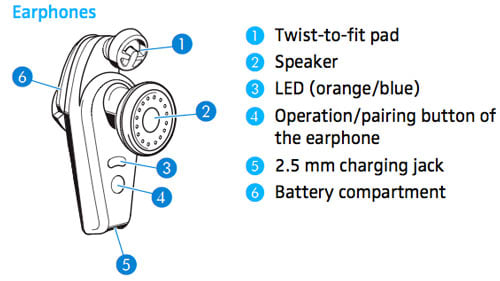
Even with the help of the above diagram, it might not be immediately clear how in tarnation you wear the things. Allow us to elucidate: the big ear piece fits under your tragus like any other in-ear headphone. The small bit at the back leverages the unit against the inside of your Pinna. Since you're most likely dazzled by our Wikipedia-granted knowledge of ear parts, here's another helpful illustration from Sennheiser.

***1.) Stick in your ear
2.) Twist to secure.***
Next on our journey of the MX W1s is the control pendant.

Once you know how this thing works, it's hard to avoid comparing it to some parasitic alien.
What you do is strap the pendant itself onto your media player, using the rubber band around its midsection. This, of course, increases the girth of your media player, making the entire shebang a bit less portable. From there, just plug it in as normal. On the pendant's top and bottom you'll find a charging port and on/off/connect button respectively. On the pendant's face you can also see a blue LED that will blink at you intermittently when you attempted to connect it.


***These are the top and bottom views of the pendant, respectively. The top has the recharging port and the bottom
has the on/off button and a little reset hole. On the picture of the bottom you can also see the device's LCD,
which will light up blue and flash to let you know it's connected.***
The last stop on our tour of the MX W1s is the charging cradle. You can drop the headphones in this, then connect this to the charging cable in order to charge both head phones and the transmitter pendant at the same time. Also, it will hold a charge so you can power up your headphones on the go. The button on its front serves to turn charging on and off.
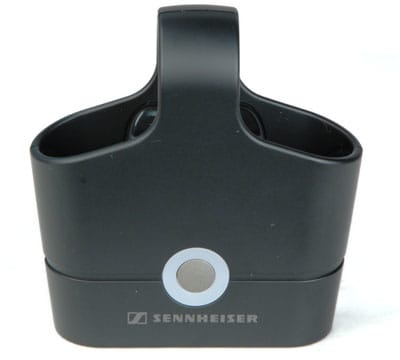
***Witness the charging cradle. When your headphones are charging,
the white area around the button will glow orange. ***

This is the charging port.
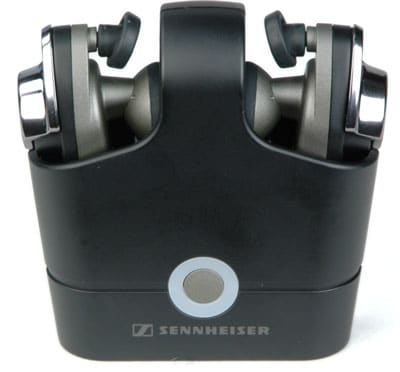
This is a shot of the MX W1s sitting comfortably in the charging cradle.
That's about it for the MX W1s, which can be a bit confusing to the uninitiated, simply because they look nothing like actual headphones. As always, we close with a shot of HATS wearing the headphones, so you can picture what you, noble reader, would look like with them on.
In the MX W1's box is packed full of junk. The astute will find the MX W1s and their receiver, a charging cradle, a leather carrying case, a USB cable, and a plug with four different socket adapters.
[
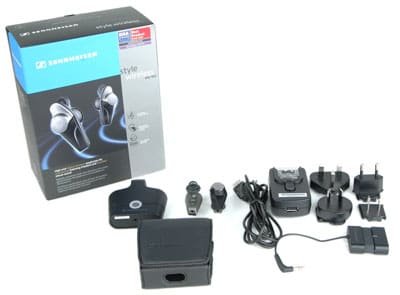
](https://www.reviewed.com/headphones/images/upload/Image/Reviews/Sennheiser/MX_W1/in-box-1000.jpg)
The MX W1s don't have a lot to them. They're elongated blobs of plastic with two protrusions and a hatch on their back for the battery. The hatch is kind of tricky to get off and we actually broke a piece on one of our review models (luckily they were broken anyway). In addition to the sleeve over the ear piece, there's a rubbery bit at the back that helps it stay in your ear. If that piece pops off, which is does with greater ease than we would've liked, it becomes nearly impossible to wear these things.
There's also the charging issue that we ran into. Sennheiser claims the first manufacturer's line had an error that caused the headphones to stop charging properly after a short period of time (we ran into the issue second day we had them). Providing you send them back to Sennheiser, they'll mail you a replacement. While we're glad this return policy is in effect, it doesn't erase the chance there's a pair of busted headphones in any given MX W1 box.
All this being said, the MX W1s also have a big durability advantage: no cord, really. Many cord durability issues stem from the cord being attached to your head. When your media player rolls around in your pocket, it tugs on your ear pieces and you tug back. This can cause wear and tear at the junction between cable and plug. Due to its design, the MX W1 circumvents this issue.
The MX W1s aren't the most attractive set of headphones we've seen. Really, you need to ask yourself if you're willing to look like you're wearing two Bluetooth headsets. Most people can't even pull off a single Bluetooth headset without looking the part of the fool. If you are one of those fortunates, however, we still have doubts you won't look like a sci-fi movie extra from the front view. Really, the only benefit to wearing two Bluetooth headsets is that, should you get a call, you can have a conversation normally without people on one side of you thinking you're insane. Unfortunately, the MX W1s don't have a microphone, so this ideal scenario will never occur. We'd honestly recommend trying these on and checking yourself out in the mirror first.
Performance
About our testing:
For more information on our tests, read this article.
**Frequency Response** *(4.19)*
How the test works:
This test measures the emphasis added or subtracted by the tested headphones. Ideally your headphones will faithfull recreate the original, but some headphones opt to dynamically alter playback to boost bass or vocals or what have you. We test the headphones' response by playing a frequency sweep through them. Since the frequency sweep plays known frequencies at known decibel levels, we can compare whatever HATS hears to the original sound to determine the headphones' response.
On the graph below, the left channel's response is in green, the right's is in red, and the dotted black lines serve as our upper and lower limits. If the lines peek ouside these limits by a few decibels, it likely won't be a big deal. If it falls/rises far outside the limits, the emphasis/deemphasis is likely too much, which will have a negative effect on sound quality.
What we found:
The MX W1s didn't have the worst frequency response. The bass end is emphasized well; it drops off at the lowest end, which should give a strong base without a lot of boominess. Towards the higher end, however, both lines drop significanly and dance around at our lower limit. They take a small dump up only to dive down past the lower limit, at which point they start getting a bit scribbly.
This loss of the high end is somewhat to be expected, given the odd way these headphones fit into your ears. When they're secure, they don't necessarily fit flush with your ear canal, which not only ruins isolation, but causes you to lose some high end as well.
Again, this isn't necessarily a bad frequency response, but the headphones do handle treble poorly.
**Distortion** *(1.76)*
How the test works:
Distortion refers to differences between the original sound wave and whatever winds up wiggling into your ear canal. The distortion test again utilizes a frequency sweep and we again check the original against the HATS-gathered playback. Of course, the ideal result here is 0% distortion, but it should be noted that distortion's effect may be considerably more noticeable when listening to certain types of music: rock, punk, and other genres often heavily utilize distortion filters to begin with, so additional distortion might not be as perceptible when compared to its affect on, say, a fully-orchestrated opera.
On the graph below, the left and right channels are again color-coded green and red respectively. Anything over 3% will definitely be noticeable.
What we found:
The MX W1 actually suffers from less distortion than we would have thought. We expected a ton of distortion because the signal needs to be compressed in order to be wirelessly transferred. Since your music is crunched to a pulp then has to fly through the air before it reaches your ear, it's understandable that some distortion exists.
Regardless of the trials and tribulations that only wireless headphones know, the distortion is definitely high in the low end. Towards the 1kHz mark, however, the distortion falls back down to nominal levels.
**Tracking** *(6.76)*
How the test works:
Tracking refers to the balance between the left and right channels. If the two channels are playing back at 100% equal decibel levels, then the heapdhones have perfect tracking. Again we turn to our perpetually useful frequency sweeps; this time we look for uneven volumes between the left and right. On the graph below, any unevenness is apparent by the blue line rising above or falling below the zero line. When the line creeps above zero, the left channel is louder. When the line falls below zero, the right channel is louder. The amount of this extra loudness is measured along the Y-axis.
What we found:
The MX W1s don't have perfect tracking, but it's not abysmal either. The main issue with tracking will undoubtedly be positioning errors. If you don't have them just right, one ear piece will generally play slightly louder than the other, and these headphones are really hard to position correctly.
This being said, if you look at the graph and how it wanders from left to right and back again, the slopes are all relatively shallow (no vertical spikes) and the amounts involved aren't particularly noticeable. A four decibel decibel difference isn't going to shock you so profoundly you pop your monocle. We've seen headphones with far better tracking, but again, the MX W1s are wireless in-ears.
**Maximum Usable Volume** *(9.31)*
How the test works:
Distortion is exacerbated by loud volumes. Maximum usable volume refers to how loud you can get your playback before overall distortion levels hit that nasty 3% mark. To do this, we simply run a series of distortion tests at varying decibel levels, until we hone in on the highest we can achieve without distortion levels going awry.
What we found:
The MX W1s were capable of a very loud 117.1dB. We award max points for 120, but anything over that is aural overkill.
**Isolation** *(0.45)*
How the test works:
Isolation refers to how much external noise the headphoens are capable of blocking out. There are two flavors of isolation: active and passive. Passive cancellation refers to how much sound is blocked out by virtue of the headphones sitting between you and the noise. Stuffing your ears with cotton balls is a form of passive cancellation. Active cancellation is very futuristic and relies on electronics and science to get the job done. Active noise cancellation relies on microphones built into the headphones. The microphones listen to the ambient noise, which lets the headphones play back a sound with an inverse amplitude. If you remember your old science class on soundwaves, you know that wave plus inverse wave equals a flat (or mostly flat) wave, which is inaudible.
We test isolation by blasting HATS with pink noise to calibrate it, then blasting it again once we've put the headphones on. On the graph below, the green line represents passive cancellation and the blue line represents active cancellation (if present). The lines themselves display the decibel levels of each frequency that are being blocked.
What we found:
The MX W1s did not have the best isolation. The ear buds don't fit really flush with the ear, so there isn't a lot to block out sounds. They don't have active cancellation either.
Because of the barely-there isolation, the MX W1s might not be the best headphones for people on the go. If you're going to walk outside, ambient noise is going to overpower (or at least rudely intrude upon) your playback. We would not recommend these for the average commuter for this reason.
**Leakage** *(7.04)*
How the test works:
Leakage refers to the amount of your playback that 'leaks' out of the headphones. Leakage is bad, because it can disrupt the world around you and shatter the privacy between you and your playback. Leakage is easy enough to test, providing we have so many precise microphones lying around: what we do is play back a known amount of pink noise through the headphones and use a spare mic to pick up any leaked sound.
What we found:
Interestingly enough, considering the poor seal, the MX W1s didn't leak much.
In Use

Just look at these things. If you expect them to feel like pillows that just barely kiss your ears, then you are being silly. The ear pieces wedge between flaps of ear skin. This being said, we didn't think the MX W1s were particularly uncomfortable. In fact, we'd go so far to say they're not much less uncomfortable than the average set of in-ears. They stay in really well too, due to their very light-weight design. If you wanted, you could take these to the gym to work out without a cord bouncing around or tucked into your shirt (which results in the cord getting tugged whenever you move your head). Of course, you'll have to deal with looking like you're wearing two Bluetooth headsets, which is typically a bad thing.
These are definitely headphones you'll want to try out before you buy. Two people in our office couldn't even wear these things properly: their ears were too small. Unless you can catch the second part on the inside of your concha, you aren't going to be getting a very good fit: the headphones won't be flush with your ear, and sound a bit tinny. They are actually a bit more comfortable if you don't wear them correctly, strangely enough.
The main issue with wearing the MX W1s for a time period of 6 hours or longer isn't necessarily one of comfort, but one of battery life: the battery won't last a full 6 hours according to our tests. In spite of this shortcoming, we wore the headphones for 6 hours straight anyway. While they certainly get slightly more uncomfortable over time, we were surprised at the relatively slow escalation of discomfort. You will probably have to reposition the headphones slightly as you wear them, to spread the pressure around, but overall, they aren't nearly as uncomfortable as their design would suggest.
**Cable Connectivity***(2.50)*
The MX W1s might be wireless, but their transmitter gets wired to your headphones. Typically cable connectivity refers to the headphones' ability to hook up to any given jack and we award points for different adapters, etc. The MX W1 transmitter does have a thin plug, which will help you hook up to a recessed jack, but the bulk of the MX W1s' points in this section comes from all the included power adapters.

This is the extent of the MX W1s' cable. We like the plug's design.
There are plugs for those of you in America, the UK, Europe, and Australia. If you plan on travelling around with these headphones, Sennheiser has you covered. Of course, all that travel means a lot of plane rides, and wireless connectivity isn't allowed on planes.

You could go pretty much anywhere in the world with the MX W1s.

**This cable can hook up to a USB port for charging, or you could attach the **
**removeable plug and charge from a wall socket. **
In-ears are the most portable style of headphones. Since they take up such little space, you can simply toss them in your pocket when they're done. We don't think that wirelessness necessarily enhances portability – in fact, the larger ear bud size actually makes them less portable than the average in-ears. The MX W1s are more portable than on-ear headphones that don't have a head band. Although this is a somewhat nebulous category of portability, rest assured: they are easy to cart around.



***This is the MX W1s' svelt carrying case. Just pop them in their charging cradle, toss the cradle in here, and you have a nice,
snug parcel you can clip to your belt if you so choose. ***
Typically in-ear headphones are very customizable, simple because it's so easy for them to be. All manufacturers have to do is toss in 20 different kinds of sleeves, where they need to be more creative with on-ears or over-ears. This doesn't really apply to the MX W1s, however, which only come with three sizes of sleeve for their bass nozzle. Three sizes of sleeve is standard for in-ears, but fancy (expensive) headphones like the MX W1s typically come with different styles of sleeve. While we understand the MX W1s aren't the typical in-ear design, it doesn't change the fact that they have less customization options than traditional in-ears.
Other than removing the sleeves, there's really not much you can do to maintain these things. This is typical for in-ears, which are typically just sealed-off plastic bubbles. If your MX W1s break or you want to mod them in any way, you'll have to prepare yourself for a very invasive, likely irriversible procedure.
Battery Dependency
The MX W1s are 100% battery dependent due to their wireless connectivity. They aren't super space-age gizmos that also connect to a power source wirelessly. If they aren't charged, you won't be getting any playback. We had some issues with charging the batteries, namely that every once in a while one of the headpieces wouldn't recognize that it was hooked up to a charge.
Wireless
The MX W1s do connect wirelessly. The transmitter has an 1/8-inch plug and comes with a rubber band that loops around both it and your media player. If you do it right, the transmitter will be latched onto your media player like a parasite.
The MX W1 doesn't have particularly good battery life, however. It lasted just under four hours on a full charge. It seems as though the ear pieces don't necessarily run out at the same time, either: sometimes one lingered for up to 10 minutes after the other had died. Granted, the MX W1s use magical wireless technology, but it doesn't do you any favors when it comes to longevity.
Value & Comparisons

Value*(1.00)*
These headphones cost $500, don't have pristine audio quality, and aren't made out of a precious metal. While we do think that wireless in-ears are a neat piece of technology, until the costs come down, they're just not feasible for the average consumer.

[

Sennheiser CX 95](https://www.reviewed.com/headphones/content/Sennheiser-CX-95-Headphones-Review-680.htm) - The CX 95s, another Sennheiser offering, are far more attractive. They have much better audio quality and a much more realistic price. For this match-up (really, all match-ups besides the DS6000) you need to ask yourself how much wireless connectivity is really worth.
[

Shure SE420](https://www.reviewed.com/headphones/content/Shure-SE420-Headphones-Review-668.htm) - The Shure SE420s isolate like crazy, but have kind of a bulky cord. If you tried these on and thought the cord felt like a heavy noose around your neck, then the MX W1s are probably a great option. Really, though, the SE420s are a lot like the CX 95s: better in just about every way, but not wireless. The SE420s are a bit pricy as wel, but they're nowhere near as expensive as the MX W1s.
[

Sony MDR-DS6000](https://www.reviewed.com/headphones/content/Sony-MDR-DS6000-Headphones-Review-247.htm) - The Sony MDR-DS6000s are a set of wireless, at-home headphones. They're meant for movie viewers and have sometimes-spotty surround sound via Dolby Digital. They don't have great audio quality, but it's about on par with the MX W1s if a bit more prone to distortion. We thought the DS6000s were overpriced at $300, but they seem like a steal compared to the MX W1s' $500. If portability matters to you in any capacity, then the MX W1s are the better wireless pick. If you're planning to use them around the house, the DS6000s are better.
[

Apple iPod In-ear Headphones](https://www.reviewed.com/headphones/content/Apple-In-ear-Headphones-Review-269.htm) - Cheap vs. expensive. Both headphones have fit issues and sub-par sound quality. Both have somewhat negative aesthetic connotations. One costs $30 and has a cord, the other costs $500 and is wireless. With such a staggering price difference, we have to ask again: how much is a wireless connection worth to you? The iPod headphones are by no means good, but we predict the MX W1's ticket price is going to be far too much for just about everyone.
[

Sennheiser MM 50 iP](https://www.reviewed.com/headphones/content/Sennheiser-MM50-iP-Headphones-Review-547.htm) - Sennheiser, what happened to great, sensibly-priced headphones like the MM 50 iPs? We love these things. They're relatively inexpensive, comfortable, have great audio quality for their price, and come with an in-line mic and control button. Really, even if you are inexplicably allergic to cords, pick up the MM 50 iPs instead.
Conclusion
Conclusion

The MX W1s seem to be more of a tech demo than an actual consumer item. It's the first marriage of Sennheiser and Kleer's wireless technology, and honestly, we can't see someone dropping $500 on these things. Not only do they look silly at best, but they aren't particularly comfortable. Also, while their sound quality is honestly impressive for a set of wireless headphones, let alone in-ears, it can't compete with other headphones. If you're khordephobic and rich, these are the headphones for you.

While audiophiles tend to spend a ton of money, there isn't much about the MX W1s' audio quality to inspire them to do so.
Physically, yes, these things are portable. They don't isolate at all, however, so taking these things outside will totally drown out your playback. If you're looking for headphones to wear while you putter around your mansion, the MX W1s are a good bet.
Comfort, longevity, and isolation issues aside, these things are wireless. Do you want to ruin the pilot's radios and radars and what have you, endangering everyone on the plane?
These really aren't a good bet for home theater users due to their somewhat uncomfortable fit and small sound stage. Stick to over-ears or on-ears.
Meet the tester
Mark Brezinski works on the Home Team, reviewing refrigerators, minifridges, dishwashers, washing machines, dryers, air conditioners, air purifiers, and fans.
Checking our work.
Our team is here to help you buy the best stuff and love what you own. Our writers, editors, and experts obsess over the products we cover to make sure you're confident and satisfied. Have a different opinion about something we recommend? Email us and we'll compare notes.
Shoot us an email